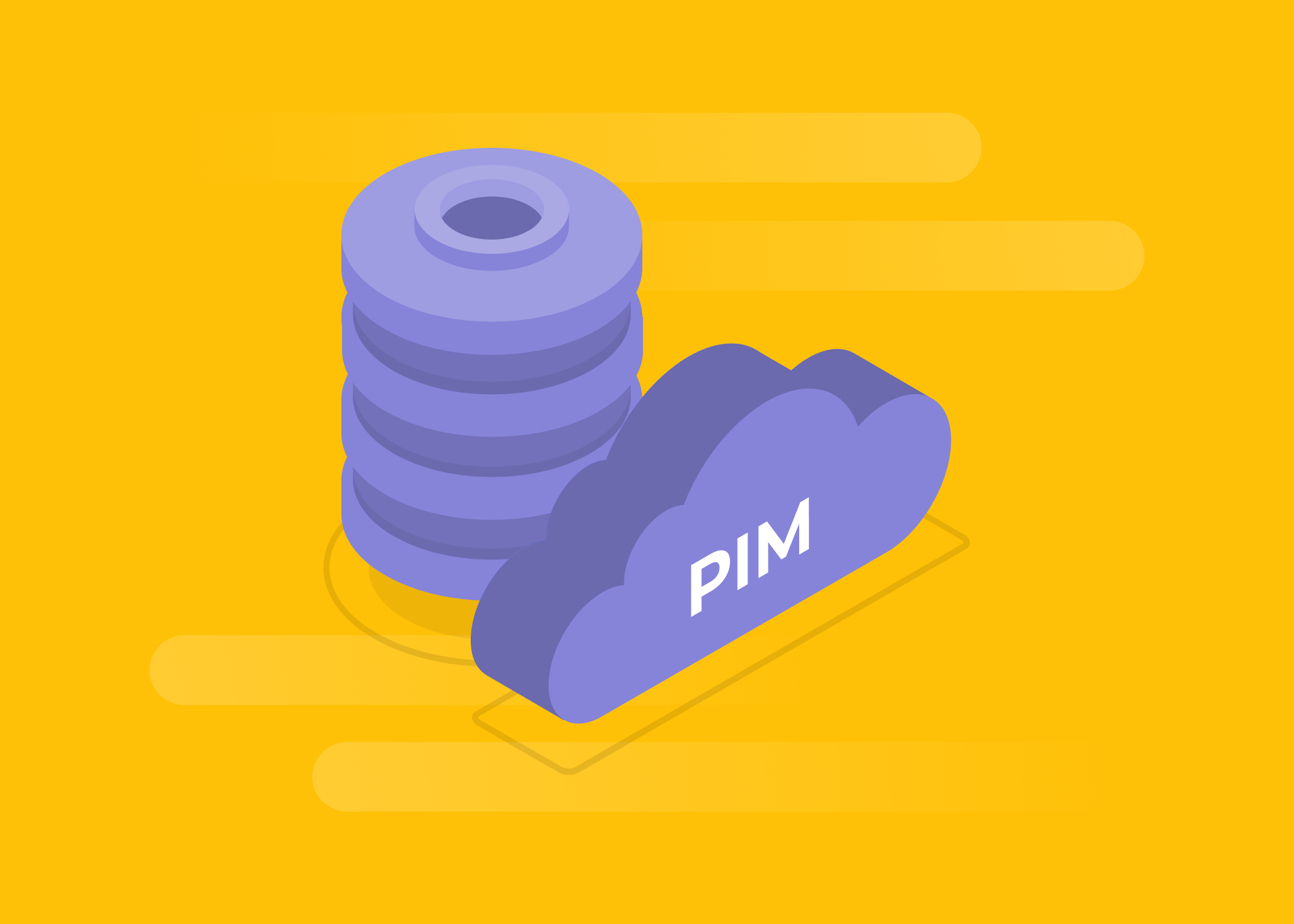Content
Magento PIM Integration - Full Guide

The company's products and services are what make a profit. Buyers search the internet and compare the information in the product descriptions, choosing the seller who provides complete, up-to-date, and relevant information.
If your company is a large retailer or manufacturer, then every day you work with thousands of names, many characteristics, and hundreds of attributes, while the information is presented in various formats. It becomes almost impossible to keep track of updating the data manually: there is too much information for a human to analyze it all in real time. PIM systems can help.
Lets talk about itHave a project in mind?
In this article, we will talk about what PIM systems are, Magento PIM integration, their benefits, and the most popular software.
What Is PIM?
A Product Information Management (PIM) system is the center for product and content management at all stages of production and sale. It is a place where you can create and edit information about products, including marketing information, datasheet, photos, and more. It is also a place where you can distribute it through any communication channels, including at points of sale, through social networks and in e-commerce.
Why use PIM
It allows you to manage the rules for the format of information saved about the product, as well as the presentation of information in different channels, taking into account their specifics. It is part of the company's IT contour, tightly integrated into other systems.
With PIM, companies can improve the completeness of product data, its accuracy and quality, speed up and simplify catalog management.
And as a result, you can quickly bring to markets products that meet consumer needs, increasing the sales and fostering new channels of communication.
How a PIM Software Can Benefit Your Ecommerce Business
PIM is essential for maintaining accurate and high-quality product information when managing thousands of orders. This is the foundation of effective content marketing, where focusing on content as a multifunctional tool for building customer loyalty and optimizing conversions is the most important.
PIM is one of the most valuable systems for any type of e-commerce targeting multi-channel sales. It is used to manage product information (e.g. name, description, photos, attributes, categories, etc.) in situations where managing such information directly on the e-commerce platform is impossible due to various circumstances. PIM software can benefit your e-commerce business in the following ways:
- Completeness of information. The structure of the database can contain any amount of formalized data on products suitable for use in both key markets - b2b and b2c;
- Structuring and uniformity. The introduction of PIM involves getting rid of the chaos in information about the products and allows you to ensure compatibility with absolutely any resources using databases - online stores and product showcases organized on a variety of platforms, product aggregators, marketplaces, advertising platforms, etc.;
- Relevance. The data only needs to be updated in one source;
- Centralization. The information is available in a single repository, it does not need to be searched in dubious sources or begged from trading partners;
- Availability. Everyone who needs information on products can at any time find in the store what is required and use it for its intended purpose;
- Variability in use. Data can be downloaded in different formats in one click, without the need to create and store many files.
Using the PIM approach allows at a more efficient level:
- Maintain up-to-date information about the products: articles, wholesale prices and discounts, data on stock balances, conditions for partners, and more;
- Manage updates of consumer information about the products: descriptions and characteristics, changes in the range, media content;
- Interact with external services and services, such as transport and logistics companies, fulfillment centers and others;
- Set up data exchange with sites and partners (including on a given schedule), providing clients and other counterparties with the necessary information on time and in the required formats, and social media and information resources with consumer data - reliable information about products that promote promoting products and brands and encouraging users to make smarter and more informed purchasing decisions;
- Manage access to your information for partners and end-users: you decide what information can be used, as well as when, by whom and under what conditions.
Unfortunately, many companies are still neglecting such opportunities provided by modern software. This often leads to a lack of consistency, an increase in the cost of maintaining reliable and timely information about the products, and some organizational problems that inevitably affect the efficiency of the business as a whole.
What are the benefits of PIM Software?
The PIM solution improves the productivity and efficiency of the company, helping to provide consumers with high-quality, reliable, and consistent product information. It helps:
- Increase sales and fewer returns;
- Improve the productivity of marketing teams;
- Expand the sales and communication channels along with assortment growth;
- Import data from any source and in any format;
- Consolidate information on all products;
- Decrease the number of errors and the duration of processing times;
- Eliminate duplicates and verify the data \;
- Control the completeness and reliability of data;
- Safely distribute the information among partners;
- Reduce the cost of managing product data;
- Reduce the time to market;
- Reduce the number of returns;
- Increase the conversion rates;
- Provide omnichannel support.
Why your Magento store requires a PIM Solution
The lack of a product description and a catalog systematization system leads to a discord between the data in various promotion channels, which not only reduces the efficiency of the ecommerce business but also confuses buyers, reducing the attractiveness of the company.
As a result, retailers and manufacturers face the following challenges:
- Lack or oversupply of items in the warehouse;
- Delays in deliveries;
- A large number of returns;
- Failure to meet the deadlines for launching new products;
- Overloading of the directory with unnecessary information;
- Difficulty communicating with suppliers and customers;
- Data inconsistency.
If your Magento-based store has any of the above problems, a PIM system will be the solution for you.
How PIM Works
All the necessary information about the product must be stored in the PIM, and only changed in the PIM. All other systems, such as the website and marketplaces, receive product information through export from the PIM.
Loading product information
First, you need to upload the product information to the system. If you manufacture the product, this information needs to be entered manually, or it comes from internal information systems linked with production.
Retailers usually get this information from manufacturers and suppliers, but this information should at least be verified, and often retailers add to this information.
PIM is inextricably linked to other information systems. As a rule, some of the information comes from the ERP (for example, product ID, prices)
Thus, this system must be able to import data from various sources. After all, we often cannot tell suppliers which format to use for data exchange. We also need to map the data that we get to the attributes that we have in the system. And it is best if this import setup is convenient and easy because the sources of these data are also constantly changing, like when we change suppliers.
Validation of product information
After the information enters the system, it is verified. For example, the system checks if all the required attributes are filled in. Checks can be both automatic and manual. Usually, all PIM systems can do automatic checks, and if something is not filled in, tasks for different departments can be automatically generated to correct these errors.
You also need to place the product in the correct category in the hierarchy. And the problem is that there can be many of them. The nomenclature tree can be one, the website can show a different classification. Each marketplace sets its hierarchy. There are also industry hierarchies. For example, ETIM also needs to be loaded into the system and the products must be classified according to them.
This means the PIM system must support many hierarchies, which must also be imported and verified. This also needs to be controlled: it is necessary to put in all these attributes and set the appropriate categories for them. The attributes often change, the business is very dynamic and it is often necessary to store additional information.
At the saturation stage, different people can work on a product, so the system must also support workflows so that employees can clearly understand what is required of them. Automatic checks and shared access are also important.
Uploading product information
And finally, when the products contain all the necessary information and it has been verified, the export of information occurs.
Exporting is not an easy thing either. It is necessary to support all possible formats. For example, different marketplaces require you to provide information in a form convenient for them, and not for you. This process can take place in batch mode or in real time when immediately after the products are changed and checked, information is transmitted to other systems.
Different sales channels require different data, you will need one set of attributes for a printed catalog, another for a website. Moreover, the data in the system is stored in a form that is convenient for you and often needs to be transformed when sent to another system. For example, units of measurement may need to be converted.
Most Popular PIM Softwares
Many retailers now use Magento 2 as the basis for their ecommerce websites. Many PIM providers can help you manage product information for your Magento store. Looking for the best PIM software to integrate with Magento 2 store? Below are the best software tools for managing product information for Magento.
Akeneo
It is an open-source custom PIM software that allows merchants to manage all the content and product data they need in one place and export it across multiple channels.
With Akeneo, you will have the ability to import data from a variety of CSV and Excel files, connect to third-party systems, and connect to your suppliers to get a clear and complete view of all imports.
InRiver
This software helps B2B and B2C multichannel commerce to process and distribute product content from a central master file across multiple sales channels in multiple languages. It also includes a Planner app, so you can track, plan activities, control the workflow, and collaborate with the sales team in PIM.
Pimcore
It is an open-source enterprise PIM software that manages both workflow and data. It structures and centralizes all technical and marketing information about products. This enables product data to be provided across all customer touchpoints.
It is the only open-source consolidated digital platform covering master data management, product information management, e-commerce, and digital asset management.
Learn how Bizol revolutionized their business with Pimcore development services. Read the full case study inside.
Salsify
Salsify is a cloud-based PIM software platform that collects and stores product descriptions, marketing content, and logistics data. It also supports content performance analytics and is available as customized pricing packages based on your business needs.
Bluestone
Bluestone PIM software has API-based, product content, and digital image management. It helps create a structure for your categories and subcategories that can be imported and exported in a variety of formats.
It speeds up new product launches and improves customer service. The Bluestone PIM Magento 2 extension provides automated and easy management of categories, images, product catalog, and attributes in Magento.
Oracle
Oracle PIM creates a single, centralized source of accurate, clean, consolidated product data at the enterprise level. The solution provides data synchronization between different systems and applications. It contains a flexible data model, a ready-made user interface for business users and data administrators. The solution supports tools for automating corporate regulations for the management of regulatory and reference information by the world's best practices.
How to Integrate a PIM system into Magento 2
Actually, there are 2 ways to integrate Magento PIM: using an extension and using an API. The first option can only be implemented by the merchant if the third-party extension meets all of the business requirements. The second is more complicated and requires some technical knowledge to install the connector and implement the solution.
To add a PIM solution to your Magento store, follow these steps:
-
Import product and category data into the PIM system;
-
Test your Magento object. Make sure the same PIM database fields exist in Magento;
-
Then create a PIM connection channel and give the fields the same name in Magento and the PIM system;
-
Install a third-party extension;
-
Perform initial tests on just a few products to make sure everything is working correctly;
-
Make sure all product content is synchronized appropriately, especially custom attributes and images, which are usually the most problematic;
-
If the results are satisfactory, add the rest of the products until the catalog is complete.
Conclusion
Choosing the omnichannel path, you will inevitably have to face the need to implement various new information systems and restructure individual business processes. In this, an important role is played by which PIM you choose.
If you have any questions about PIM and your ecommerce business, we are happy to answer them. Just contact us to get a consultation or a project estimate by top ecommerce experts.
Lassen Sie Profis Ihre Herausforderung meistern
Unsere zertifizierten Spezialisten finden die optimale Lösung für Ihr Unternehmen.



